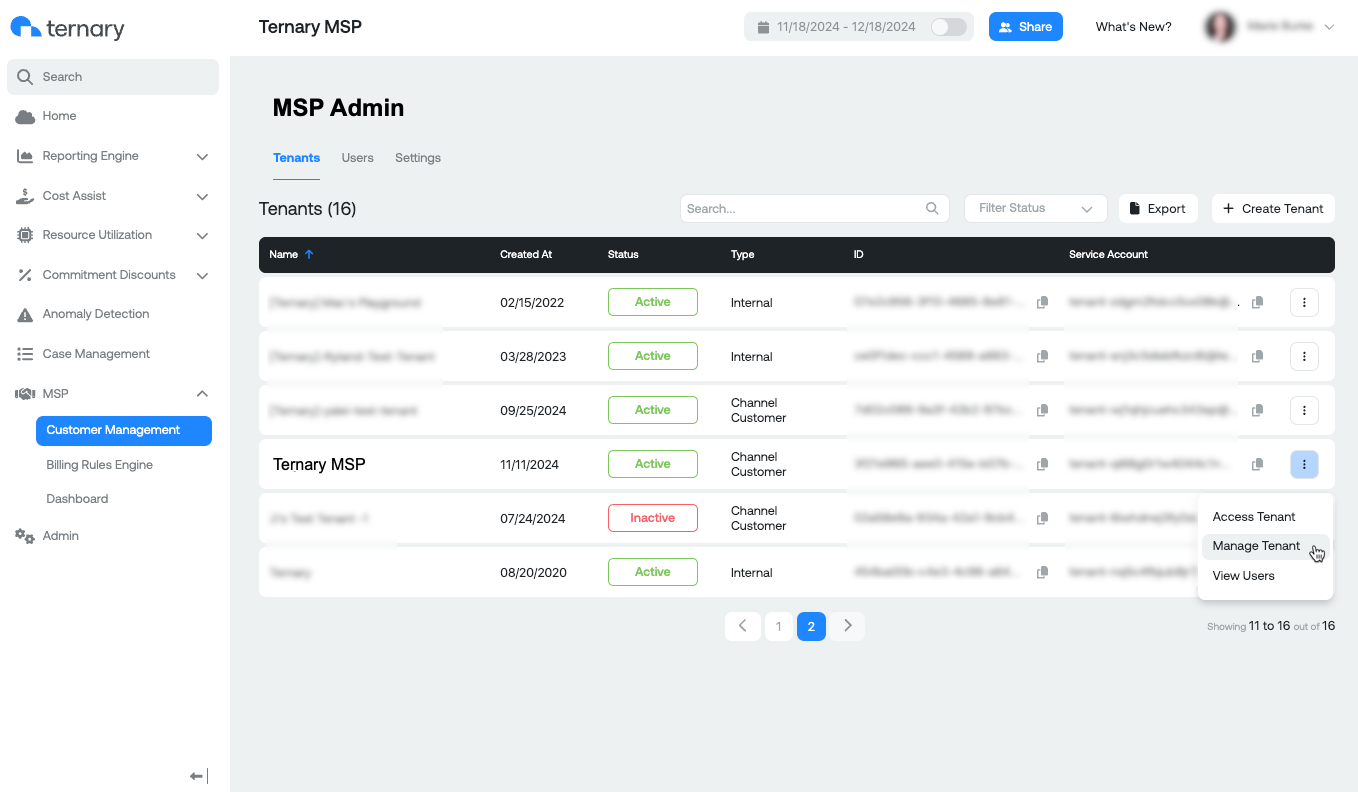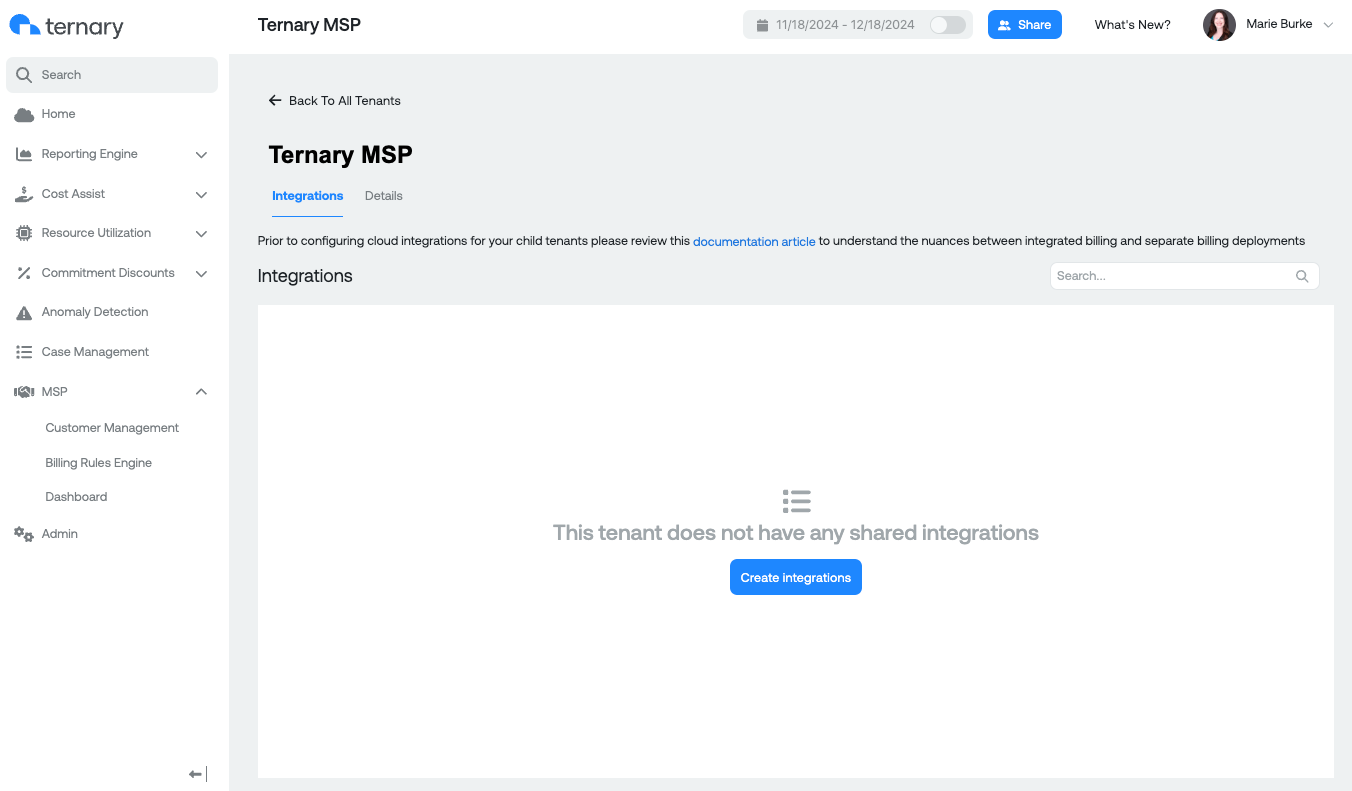MSP Bill Splitting
Overview
As a Managed Service Provider (MSP), you likely manage cloud integrations within your tenant, where you configure and maintain connections to cloud providers on behalf of your customers. In this setup, referred to as Integrated Billing, your customers may be linked to specific projects, accounts, or subscriptions under your MSP Parent Tenant. To effectively manage and track cloud usage for each individual customer, it's essential to separate or split these integrations.
With Ternary’s MSP Bill Splitting functionality, you can easily separate billing data for each end customer. This self-service feature allows you to efficiently allocate and manage cloud usage, ensuring accurate billing and reporting for your customers.
Key benefits
- Reduces MSP operational overhead
- Prevents unallocated or missing billing data
- Automatically adapts as your customer environments evolve
- Works across multiple cloud providers
- Aligns to your cloud provider’s native billing structure
Permissions required
To access and use this feature, you must have the Partner Admin role.
Note: If you're unsure who your Partner Admin is, please contact your Customer Success Manager for assistance or open a Ternary Support Request.
How it works
Step 1: Access the Bill Splitting functionality
- In the left-hand navigation, go to MSP Customer Management.
- Find and select the customer for whom you want to create shared integrations.
- Click the ellipsis menu (three dots) next to the customer.
- Select Manage Tenant from the dropdown menu.

Step 2a: Create integrations
Once you're on the Manage Tenant page, you'll be able to view any shared integrations that have already been created. If you're new to using the Bill Splitting mechanism or have recently partnered with Ternary, follow these steps to create your integration(s):
- Click the Create Integrations button to begin.

Step 2b: Select a Billing Dimension (New)
Before adding Sub Accounts, you will be asked to select the Dimension that defines the billing boundary for this child tenant.
A Dimension defines how Ternary identifies and groups cloud accounts for shared billing.
| Cloud provider | Dimensions | Description |
|---|---|---|
| AWS | Sub Account ID, Sub Account Name | AWS Linked Accounts must be selected individually at this time. No higher-level grouping is currently supported. |
| Azure | Sub Account ID, Sub Account Name, Invoice Section Name, Invoice Section ID | If Invoice Section fields are present in your billing data, selecting them will automatically include all Sub Accounts belonging to that Invoice Section. |
| GCP | Sub Account ID, Sub Account Name, Folder / Ancestry Path, Folder / Ancestry ID | Higher-level grouping appears only if organizational hierarchy metadata is included in the billing export. |
| OCI | Sub Account ID, Sub Account Name | OCI compartments/tenancies must be assigned individually at this time. No higher-level grouping is currently supported. |
| Snowflake | Sub Account ID, Sub Account Name | Assign Snowflake accounts individually. Hierarchical billing structures are not currently supported |
Note:
- Selecting a higher-level grouping (e.g., Azure Invoice Section, GCP Folder) means new Sub Accounts created under that grouping will automatically be included in this tenant going forward.
- Selecting Sub Account ID means you will need to manually add Sub Accounts later if customer environments expand.

Step 2c: Assign selections (New)
After selecting the cloud provider and billing dimension, the next step is to assign the Sub Accounts that belong to the child tenant based on the dimension selected.
This page displays all the matching billing integrations that are available at the MSP parent level.
What can you do on this page?
Search by Sub Account Name or ID.
Filter by:
- Integration (e.g., AWS, Azure, GCP, OCI)
- Dimension Value (e.g., Invoice Section Name, Folder Path)
- Select or deselect the Sub Accounts to assign to this customer tenant.

Step 2d: Review and Save
After selecting the appropriate Sub Accounts:
- Review your assignments on the Review and Save page
- Confirm the tenant will receive billing data for the chosen Dimension and Sub Accounts
- Click Save to apply the configuration

Once you click Submit, you will be redirected back to the Manage Tenants page. Here, you can:
- View the status of your integrations.
- See the last refresh date for each integration.
- Update or remove assignments at any time.
Note: If this tenant had any shared integrations created previously, they will also appear on this page.

Step 3: Create or Update Integrations
In this step, you can either Create Integrations or Update Integrations:
- Create Integrations: This will take you back to Step 2b to create new integrations.
- Update Integrations: This will take you to a workflow similar to Step 2c, where you can manage existing integrations.
| Action | When to use | What happens |
|---|---|---|
| Create Integrations | Setting up billing for a child tenant for the first time | Provisions new cloud billing integrations in the tenant using the Dimension and Sub Accounts selected |
| Update Integrations | Adjusting existing tenant mappings | Opens the Assign Selections screen where you can add or remove Sub Accounts assignments |
Step 3a: Update Integrations
In the Update workflow, you’ll see all integrations associated with the current customer tenant. Here you can:
- Select or deselect subaccounts as needed.
You will see:
- A list of all Sub Accounts currently assigned to this tenant (shown in the “Selected” section at the top)
- All other Sub Accounts available for assignment based on the selected Provider + Dimension
Important notes:
- If no subaccounts are selected, the Submit button will be disabled. At least one subaccount must be selected to proceed.
- To delete an integration entirely, go to the child tenant and remove the cloud integration from the Clouds tab within the Admin section.
- If a subaccount is linked to a different child tenant, you can click View Tenant Subaccounts to be redirected to the associated tenant.
Step 3b: Review and Save
Once your selections are complete:
- Click Review to review your selections, similar to Step 2c.
- Confirm the Cloud Provider, Dimension, and all selected Sub Accounts.
- Once you're satisfied with your choices, click Submit to finalize the process.
After saving, you will be returned to the Manage Tenants page.
Note: You should begin seeing data in your customer tenants within one business day. If data is not populated by then, please open a support ticket for assistance.
Updated about 2 months ago
